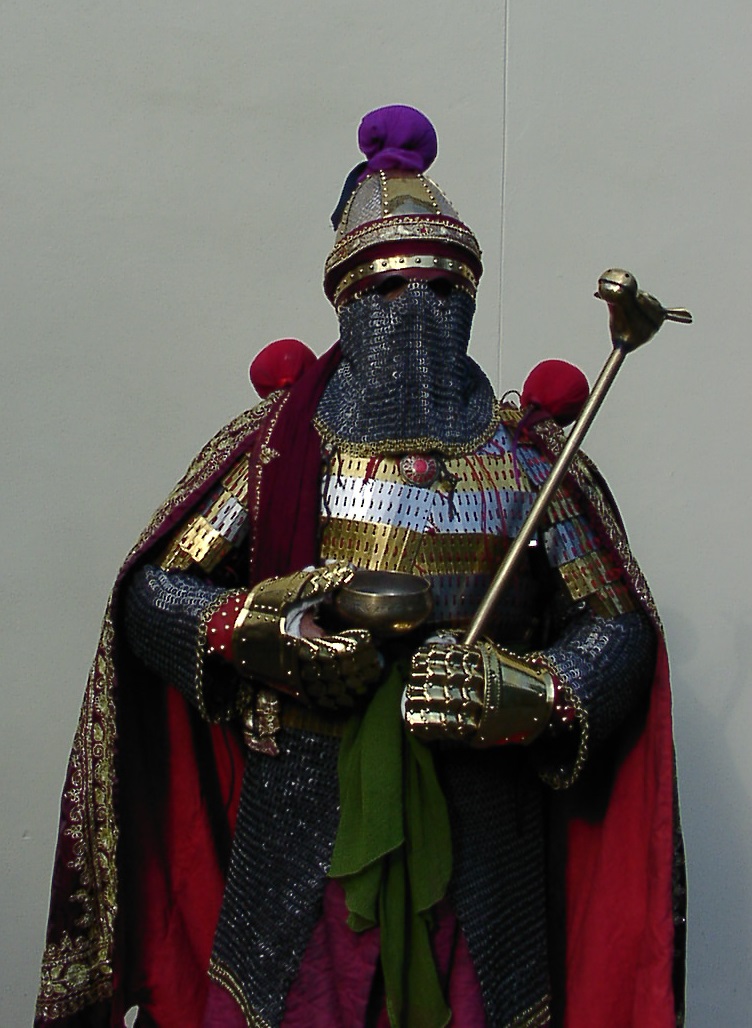|
Farrukhan The Great
Farrukhan the Great ( Persian: فرخان بزرگ, ''Farrukhan-e Bozorg''; 712–728) was the independent ruler (''ispahbadh'') of Tabaristan in the early 8th century, until his death in 728. He is the first actually attested (through his coinage) member of the Dabuyid dynasty, which is traditionally held to have ruled Tabaristan since the time of the Arab conquest of Iran. He successfully defended his realm against the Umayyad Arabs and Turks in the east and Daylamites in the west. He was also notable for being an active builder, constructing the city of Sari, where he moved his court. He was succeeded by his eldest son, Dadhburzmihr. Background Literary sources are very scarce on the Dabuyid dynasty. They are mainly known through the local histories of Ibn Isfandiyar () and Zahir al-Din Mar'ashi (d. after 1489), while they only get briefly mentioned by early Islamic-era historians such as Khalifah ibn Khayyat (d. 854), al-Tabari (d. 923), and Ali ibn al-Athir (d. 1233); ... [...More Info...] [...Related Items...] OR: [Wikipedia] [Google] [Baidu] |
Ispahbadh
''Spāhbed'' (also spelled ''spahbod'' and ''spahbad'') is a Middle Persian title meaning "army chief" used chiefly in the Sasanian Empire. Originally there was a single ''spāhbed'', called the , who functioned as the generalissimo of the Sasanian army. From the time of Khosrow I ( 531–579) on, the office was split in four, with a ''spāhbed'' for each of the cardinal directions.Gyselen (2004) After the Muslim conquest of Persia, the ''spāhbed'' of the East managed to retain his authority over the inaccessible mountainous region of Tabaristan on the southern shore of the Caspian Sea, where the title, often in its Islamic form ( fa, اسپهبذ; in ar, اصبهبذ ), survived as a regnal title until the Mongol conquests of the 13th century.Bosworth (1978), pp. 207–208 An equivalent title of Persian origin, '' ispahsālār or sipahsālār'', gained great currency across the Muslim world in the 10th–15th centuries. The title was also adopted by the Armenians ( hy, սպա� ... [...More Info...] [...Related Items...] OR: [Wikipedia] [Google] [Baidu] |
Ibn Isfandiyar
Baha al-Din Muhammad ibn Hasan ibn Isfandiyar ( fa, بهاءالدین محمد بن حسن بن اسفندیار), commonly known as Ibn Isfandiyar (), was a 13th-century Iranian historian from Tabaristan, who wrote a history of his native province, the ''Tarikh-i Tabaristan''. What little is known of his life comes from the introduction of this work. Biography Ibn Isfandiyar belonged to a prominent bureaucratic family from Sari, the capital of Tabaristan. His father Ḥasan, was a high-ranking court official of the Bavandids, the ruling dynasty of Tabaristan. In his early career, Ibn Isfandiyar was a member of the court of the Bavandids, and enjoyed the patronage of Ardashir I (died 1206). He began compiling material for his history in 1206, which up to then mainly consisted of the "Bavand-nameh", a now-lost work presumably in Persian which our author viewed as a Bavandid romance only. In 1209 he travelled briefly to Baghdad. On his return he stayed for two months in Rayy, ... [...More Info...] [...Related Items...] OR: [Wikipedia] [Google] [Baidu] |
Qarinvandids
The Qarinvand dynasty (also spelled Karenvand and Qarenvand), or simply the Karenids, was an Iranian dynasty that ruled in parts of Tabaristan ( Mazandaran) in what is now northern Iran from the 550s until the 11th-century. They considered themselves as the inheritors of the Dabuyid dynasty, and were known by their titles of ''Gilgilan'' and ''Ispahbadh''. They were descended from Sukhra, a Parthian nobleman from the House of Karen, who was the ''de facto'' ruler of the Sasanian Empire from 484 to 493. History The dynasty was founded by Karen, who in return for aiding the Sasanian king Khosrow I (r. 531–579) against the Western Turkic Khaganate, Turks, received land to the south of Amol in Tabaristan. During the 7th century, an unnamed ruler from the Qarinvand dynasty was granted parts of Tabaristan by the Dabuyids who ruled in the area. In 760, the Dabuyid ruler Khurshid was defeated, his dynasty abolished and Tabaristan annexed by the Abbasids, but the Qarinvand and other ... [...More Info...] [...Related Items...] OR: [Wikipedia] [Google] [Baidu] |
Daylam
Daylam, also known in the plural form Daylaman (and variants such as Dailam, Deylam, and Deilam), was the name of a mountainous region of inland Gilan, Iran. It was so named for its inhabitants, known as the Daylamites. The Church of the East established a metropolitan diocese for Daylam and Gilan around 790 under Shubhalishoʿ., p. 166. See also *Buyid dynasty * Daylami language *Talysh people * al-Daylami *Zaydiyyah *Nizari Ismaili state The Nizari state (the Alamut state) was a Shia Nizari Ismaili state founded by Hassan-i Sabbah after he took control of the Alamut Castle in 1090 AD, which marked the beginning of an era of Ismailism known as the "Alamut period". Their people ... References Bibliography * Historical regions of Iran History of Gilan {{Iran-geo-stub ... [...More Info...] [...Related Items...] OR: [Wikipedia] [Google] [Baidu] |
Arab Caliphate
A caliphate or khilāfah ( ar, خِلَافَة, ) is an institution or public office under the leadership of an Islamic steward with the title of caliph (; ar, خَلِيفَة , ), a person considered a political-religious successor to the Islamic prophet Muhammad and a leader of the entire Muslim world (ummah). Historically, the caliphates were polities based on Islam which developed into multi-ethnic trans-national empires. During the medieval period, three major caliphates succeeded each other: the Rashidun Caliphate (632–661), the Umayyad Caliphate (661–750), and the Abbasid Caliphate (750–1258). In the fourth major caliphate, the Ottoman Caliphate, the rulers of the Ottoman Empire claimed caliphal authority from 1517. Throughout the history of Islam, a few other Muslim states, almost all hereditary monarchies such as the Mamluk Sultanate (Cairo) and Ayyubid Caliphate, have claimed to be caliphates. The first caliphate, the Rashidun Caliphate, was established ... [...More Info...] [...Related Items...] OR: [Wikipedia] [Google] [Baidu] |
Muslim Conquest Of Persia
The Muslim conquest of Persia, also known as the Arab conquest of Iran, was carried out by the Rashidun Caliphate from 633 to 654 AD and led to the fall of the Sasanian Empire as well as the eventual decline of the Zoroastrian religion. The rise of the Muslims in Arabia coincided with an unprecedented political, social, economic, and military weakness in Persia. Once a major world power, the Sasanian Empire had exhausted its human and material resources after decades of warfare against the Byzantine Empire. The Sasanian state's internal political situation quickly deteriorated after the execution of King Khosrow II in 628. Subsequently, ten new claimants were enthroned within the next four years.The Muslim Conquest of Persia By A.I. Akram. Ch: 1 Following the Sasanian civil war of 628–632, the empire was no longer centralized. Arab Muslims first attacked Sasanian territory in 633, when Khalid ibn al-Walid invaded Mesopotamia (then known as the Sasanian province of '' ... [...More Info...] [...Related Items...] OR: [Wikipedia] [Google] [Baidu] |
Jamasp
Jamasp (also spelled Zamasp or Djamasp; pal, 𐭩𐭠𐭬𐭠𐭮𐭯; fa, جاماسپ ''Jāmāsp'') was Sasanian King of Kings of Iran from 496 to 498/9. He was a son of Peroz I and younger brother of Kavad I. Jamasp was installed on the Sasanian throne upon the deposition of the latter by the nobility and clergy. Name Due to increased Sasanian interest in Kayanian history, Jamasp was named after Jamasp, the mythological minister of the Kayanian monarch Vishtaspa. The name is transliterated in Greek as ''Zamásphēs''; Arabic ''Jāmāsb'', ''Zāmāsb'', and ''Zāmāsf''; New Persian ''Jāmāsp'' and ''Zāmāsp''. Background In 484, Peroz I () was defeated and killed by a Hephthalite army near Balkh. His army was completely destroyed, and his body was never found. Four of his sons and brothers had also died. The main Sasanian cities of the eastern region of Khorasan−Nishapur, Herat and Marw were now under Hephthalite rule. Sukhra, a member of the Parthian House of Kar ... [...More Info...] [...Related Items...] OR: [Wikipedia] [Google] [Baidu] |
Sasanian
The Sasanian () or Sassanid Empire, officially known as the Empire of Iranians (, ) and also referred to by historians as the Neo-Persian Empire, was the History of Iran, last Iranian empire before the early Muslim conquests of the 7th-8th centuries AD. Named after the Sasanian dynasty, House of Sasan, it endured for over four centuries, from 224 to 651 AD, making it the longest-lived List of monarchs of Persia, Persian imperial dynasty. The Sasanian Empire succeeded the Parthian Empire, and re-established the Persians as a major power in late antiquity alongside its neighbouring arch-rival, the Roman Empire (after 395 the Byzantine Empire).Norman A. Stillman ''The Jews of Arab Lands'' pp 22 Jewish Publication Society, 1979 International Congress of Byzantine Studies ''Proceedings of the 21st International Congress of Byzantine Studies, London, 21–26 August 2006, Volumes 1–3'' pp 29. Ashgate Pub Co, 2006 The empire was founded by Ardashir I, an Iranian ruler who rose to po ... [...More Info...] [...Related Items...] OR: [Wikipedia] [Google] [Baidu] |
Ibn Khurdadbih
Abu'l-Qasim Ubaydallah ibn Abdallah ibn Khordadbeh ( ar, ابوالقاسم عبیدالله ابن خرداذبه; 820/825–913), commonly known as Ibn Khordadbeh (also spelled Ibn Khurradadhbih; ), was a high-ranking Persian bureaucrat and geographer in the Abbasid Caliphate. He is the author of the earliest surviving Arabic book of administrative geography. Biography Ibn Khordadbeh was the son of Abdallah ibn Khordadbeh, who had governed the northern Iranian region of Tabaristan under the Abbasid caliph al-Mamun (), and in 816/17 conquered the neighbouring region of Daylam, as well as repelled the Bavandid ''ispahbadh'' (ruler) Shahriyar I () from the highlands of Tabaristan. Ibn Khordadbeh's grandfather was Khordadbeh, a former Zoroastrian who was convinced by the Barmakids to convert to Islam. He may have been the same person as Khordadbeh al-Razi, who had provided Abu'l-Hasan al-Mada'ini (died 843) the details regarding the flight of the last Sasanian emperor Yazdeger ... [...More Info...] [...Related Items...] OR: [Wikipedia] [Google] [Baidu] |
Ibn Al-Faqih
Aḥmad ibn Muḥammad ibn al-Faqih al-Hamadani ( fa, احمد بن محمد ابن الفقيه الهمذانی) (floruit, fl. 902) was a 10th-century Persians, Persian historian and geographer, famous for his ''Mukhtasar Kitab al-Buldan'' ("Concise Book of Lands") written in Arabic. In the 1870s the Dutch orientalist Michael Jan de Goeje edited a selection of geography works of Arab geographers in an eight-volume series titled ''Bibliotheca geographorum Arabicorum'' published by Lugduni-Batavae (Leiden) Brill publishers. Al-Hamadhānī's ''Mukhtasar Kitab al-Buldan'' was published in volume 5 of this series. In 1967 second editions were printed by Dar Sadir (Beirut) and E.J. Brill (Lugduni Batavorum). See also * Manuscript 5229. References [...More Info...] [...Related Items...] OR: [Wikipedia] [Google] [Baidu] |
Ali Ibn Al-Athir
Abū al-Ḥasan ʿAlī ibn Muḥammad ibn Muḥammad ash-Shaybānī, better known as ʿAlī ʿIzz ad- Dīn Ibn al-Athīr al-Jazarī ( ar, علي عز الدین بن الاثیر الجزري) lived 1160–1233) was an Arab or Kurdish historian and biographer who wrote in Arabic and was from the Ibn Athir family. At the age of twenty-one he settled with his father in Mosul to continue his studies, where he devoted himself to the study of history and Islamic tradition. Biography Ibn al-Athir belonged to the Shayban lineage of the large and influential Arab tribe Banu Bakr, who lived across upper Mesopotamia, and gave their name to the city of Diyar Bakr. He was the brother of Majd ad-Dīn and Diyā' ad-Dīn Ibn Athir. Al-Athir lived a scholarly life in Mosul, often visited Baghdad and for a time traveled with Saladin's army in Syria. He later lived in Aleppo and Damascus. His chief work was a history of the world, ''al-Kamil fi at-Tarikh'' ('' The Complete History''). He ... [...More Info...] [...Related Items...] OR: [Wikipedia] [Google] [Baidu] |


.png)